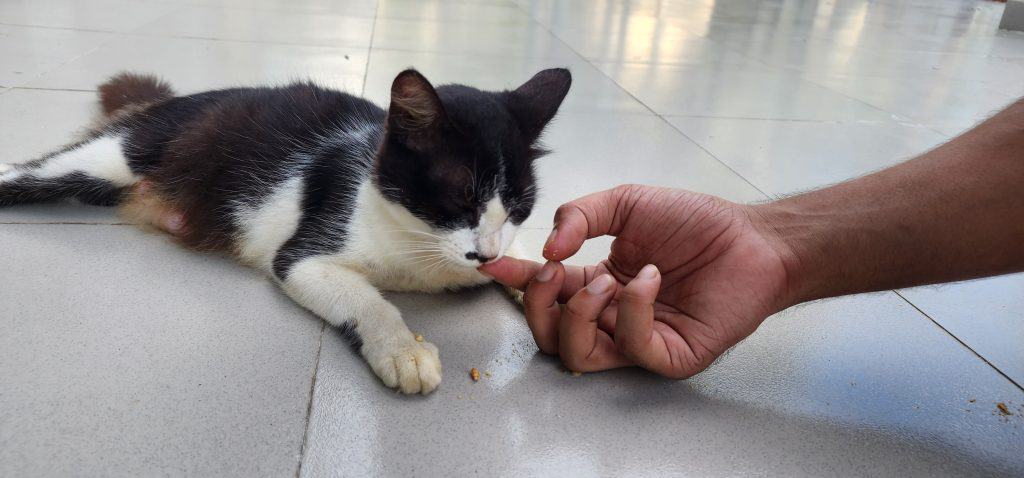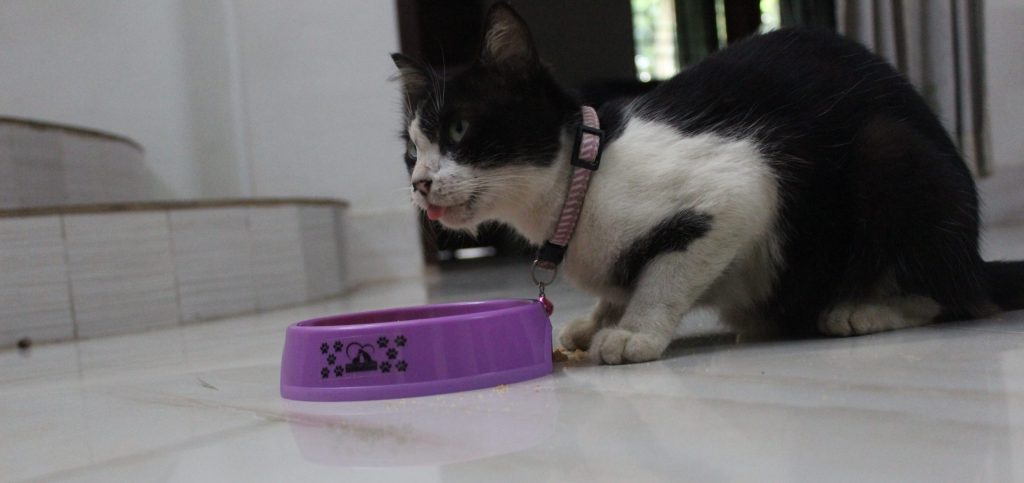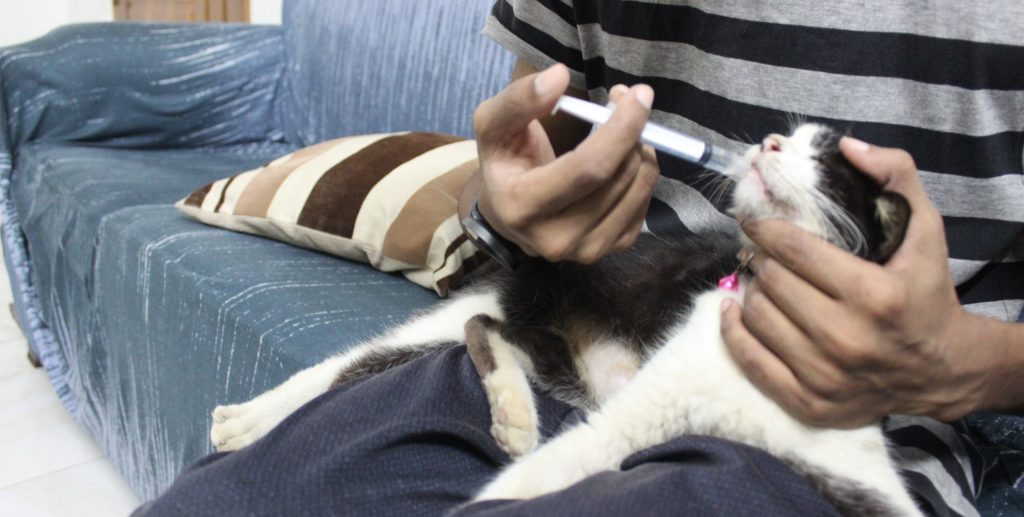Hills A/D is a widely recognized high-calorie canned food often prescribed for cats recovering from various health conditions, especially when they struggle to eat solid food and need extra nutritional support. However, some cats, like my Muezza, may find its strong scent or specific ingredients unappealing, leading to rejection or even vomiting. This can be incredibly frustrating when your beloved feline needs every bit of nutrition.
So, what are the reliable Hills A/D alternatives? From my personal experience with Muezza, my own recovering cat, she responded remarkably well to these high-calorie alternative cat foods:
- The Royal Canin’s Veterinary Diet Recovery
- Blue Wilderness Chicken
- Natural Balance Ultra-Premium Chicken & Liver
- Wellness CORE Chicken
- ProPlan True Nature Beef And Giblets
- Heinz Chicken with Broth or Beef with Broth (as a short-term supplement)
This article will delve into suitable high-calorie cat food alternatives to Hills A/D, reviewing their calorie content per unit (oz or can) and effective feeding methods that worked for Muezza and might help your own recovering cat.
Six High-Calorie Cat Foods For Hills A/D Alternative – A Quick Overview
Check out the following high-food calories for your recovering cat that can serve as alternatives to the Hills A/D cat food. Their calorie content is indicated per oz.
| Hills A/D Alternatives | Calories Content (Approximate) |
| Blue Wilderness Chicken | 44 calories per oz |
| The Royal Canin’s Veterinary Diet Recovery | 41 calories per oz |
| Natural Balance Ultra-Premium Chicken & Liver | 40 calories per oz |
| Wellness CORE Chicken | 39 calories per oz |
| ProPlan true nature beef and Giblets | 37 calories per oz |
| Heinz Chicken with Broth or Beef with Broth | 33 calories per oz (for beef) |
Exploring Six High-Calorie Cat Food Alternatives to Hills A/D
Let’s have an in-depth discussion on these highly recommended A/D food alternatives for your recovering cat, sharing my experiences and observations.
1. Royal Canin’s Veterinary Diet Recovery Food
Royal Canin’s Veterinary Diet Recovery food is frequently prescribed by veterinarians as an alternative to Hills A/D. It’s generally accessible and, in my experience, quite affordable, with a 5.5 oz can typically costing around $4.30 at local pet supply stores.
While it has approximately 24% protein content compared to A/D food’s 26.8%, you might need to feed slightly more quantities of Royal Canin’s food to match the protein intake. A 5.5 oz can contains about 183 calories, which I found was sufficient to meet Muezza’s daily needs during her recovery.
Royal Canin’s Veterinary Diet Recovery food is particularly recommended by vets for cats recovering from conditions like hepatic lipidosis, a serious fatty liver disease often seen in cats who have gone extended periods without eating.
2. Blue Wilderness Chicken (High-Calorie, Grain-Free)
The Blue Wilderness Chicken alternative is a protein-rich and 100% grain-free option, which is important for many cats with sensitivities. I found it to be light in texture and easily formable into meatballs for hand-feeding. If you need to use a syringe for administration, simply mixing it with a little water makes for an effortless, smooth flow and easier swallowing for your cat.
Compared to Hills A/D, Blue Wilderness offers a higher caloric density, with approximately 242 calories in every 5.5 oz can, while A/D typically has around 180 calories in a similar 5.5 oz can. The Blue Wilderness chicken variety usually costs between $4 and $5 for a 5.5 oz can, making it a competitive choice.
3. Natural Balance Ultra-Premium Chicken & Liver Pate
The Natural Balance Ultra-Premium alternative is quite comparable to the A/D type, providing around 180 calories per 5.5 oz can. It features a palatable chicken and liver pate formula, often with tiny pieces of carrots, designed to offer a balanced diet.
What I particularly appreciated, and what worked well for Muezza, was that the strong, pungent smell often associated with Hills A/D was not present in this food. Instead, its pleasant scent made feeding time much more enjoyable for both of us! It’s also often more budget-friendly compared to A/D food, typically retailing for about $1.80 to $2.50 per 5.5 oz can.
4. Wellness CORE Chicken (Nutrient-Dense Option)
Wellness CORE Chicken is another excellent alternative to Hills A/D food, providing approximately 39 calories per oz. While this makes it an average source of proteins compared to some others, it’s part of their “complete health” variety, which typically offers 180-220 calories per 5.5 oz can, averaging 33-40 calories in every oz.
I found Wellness CORE Chicken to have a more watery consistency, making it remarkably easy to administer using syringes and feeding tubes when Muezza needed them most. At local pet supply stores, a 5.5 oz can usually costs between $3.50 and $4.50.
5. ProPlan True Nature Beef And Giblets (Muscle Support)
ProPlan True Nature, rich in beef and giblets, boasts a high protein content essential for muscle-building in your recovering cat. It has an average of 37 calories per oz, positioning it as a moderate yet effective A/D cat food alternative, especially suitable for small breeds or cats needing a protein boost.
Muezza particularly preferred ProPlan True Nature Beef and Giblets, likely due to its appealing chicken, liver, and turkey supplements. At about $2.50 per can, I often found that just one can provided all the necessary calories Muezza needed for a day.
6. Heinz Chicken with Broth or Beef with Broth (Syringe-Friendly Supplement)
If you are syringe feeding your cat, Heinz Chicken with Broth or Beef with Broth can be incredibly helpful. Its soupy consistency makes it flow very easily through a syringe. Muezza, my cat, absolutely adored this baby food, and while primarily marketed for human babies, it can be used as a short-term, high-palatability supplement for recovering cats, but always under veterinary guidance due to it not being nutritionally complete for felines.
Heinz offers several varieties, such as chicken with broth or beef with broth. The beef variety typically has about 180 calories in a 100ml can, while the chicken broth variety has approximately 130 calories in a 100ml can. The chicken variety, often richer in protein, is generally recommended for critically injured cats needing concentrated nutrition.
How To Feed A/D Cat Food And Its Alternatives?
Below are the various methods I used to feed Muezza, and you can try them out to see which one your cat will prefer.
● Feeding By Hand

Hand feeding is ideal when your cat is a bit more recovered and capable of chewing and swallowing meatballs formed from wet cat food. I always ensured the balls were made in small, manageable sizes to prevent any choking hazards for Muezza.
For instance, I would divide a 5.5 oz can of Blue Wilderness into five portions and then gently form about eight mini meatballs from each portion.
● Using a Bowl for Independent Feeding:

Bowls are efficient once your cat has regained higher energy levels. This allows your cat to comfortably chew meatballs and lap up liquid food. You can often leave your cat to feed from the bowl with minimal supervision once they are stable enough.
● Feeding with a Spoon (Gentle Approach):
A spoon is a more basic, gentle method suitable for a reasonably recovered cat capable of swallowing liquid food. I found this helpful after Muezza had started to regain her energy and was more interactive, making meal times a more comforting experience.
● Feeding Through Syringe (Crucial for Weak Cats):

Syringes are commonly used for most recovering cats who lack the energy or ability to push food to the back of their mouth for swallowing. Different syringe sizes are available depending on your cat’s age and size, designed to deliver food directly into the mouth.
From my experience when feeding Muezza (who is 2 years and eight months old), I successfully used a 10ml/cc syringe to administer high-calorie wet cat food. Always consult your veterinarian for the most convenient and safe syringe size for your cat.
● Feeding Through a Tube (For Critical Cases):
A feeding tube is reserved for highly ill or debilitated cats who cannot swallow food even when it’s placed in their mouth. The cat food is typically mixed with water to ensure it’s a very thin consistency for easy flow.
The tube is carefully inserted into the cat’s mouth, down into the esophagus, allowing food to slowly trickle into the stomach for digestion. It’s absolutely crucial to be extremely careful and follow veterinary instructions precisely to avoid over-feeding or choking your cat when using this method.
[Understanding Esophagostomy Tubes in Cats]
Essential Precautions When Feeding Your Cat on A/D Food and Their Alternatives
Feeding your recovering cat these food supplements requires careful precautionary measures to ensure their safety and well-being. Always prioritize your cat’s health and follow these steps.
- Step 1: Consult Your Veterinarian First. Always consult with your veterinarian before introducing any A/D food or its alternatives. They will provide tailored advice on the right type and amount of food to give your cat, based on their specific weight, underlying health condition, and stage of recovery.
- Step 2: Administer Small, Frequent Meals. It’s vital to feed your cat A/D food or its alternatives in small, frequent amounts throughout the day. This is especially important if your cat is recovering from surgery or a severe illness, as it aids digestion and prevents overwhelming their system.
- Step 3: Adjust Consistency with Water. Mix A/D food or its alternatives with a small amount of water to achieve a thinner consistency. This makes it significantly easier for your cat to eat, especially if they are weak or being syringe-fed.
- Step 4: Utilize Syringes or Droppers When Needed. If your cat is unable to eat on their own, or is reluctant to eat from a bowl, using a syringe or dropper is an effective way to ensure they receive essential nutrition.
- Step 5: Proper Storage for Freshness. Always store opened A/D food and its alternatives in a cool, dry place, typically refrigerated, and adhere to the manufacturer’s guidelines for how long it can be safely stored after opening. Discard any uneaten food after a few hours to prevent bacterial growth.
FAQs
Read the frequently asked questions below by cat owners looking for the best Hills A/D alternatives, based on common inquiries and my own experiences.
Q: How Long Should One Feed Their Recovering Cat On Hills A/D Cat Food And Their Alternatives?
Depending on your vet’s prescription and your cat’s progress, you should generally feed your cat on these supplemental foods for a period determined by your veterinarian, which can sometimes be up to six months. These high-calorie feeds are designed as supplemental support to help boost your cat’s immunity, provide energy for muscle recovery, and aid overall healing.
Q: Which Is The Best Alternative For Hills A/D Cat Food?
There are several excellent paste and wet cat food options in the market that can substitute A/D cat food, and what’s “best” often depends on your cat’s specific needs and preferences. Your choice will be influenced by factors like calorie content, specific ingredients, and what your cat finds palatable.
However, from my personal experience with Muezza, my mixed Persian breed, ProPlan True Nature Beef and Giblets, along with Royal Canin’s Veterinary Diet Recovery, worked exceptionally well within just a few weeks of consistent feeding.
Q: Can You Purchase Hills a/d Alternative Food Supplements Over The Counter?
Yes. Many of the high-calorie cat foods mentioned, such as Blue Wilderness, Natural Balance, and Wellness CORE, are readily available in pet stores, larger supermarkets, and online retailers, and generally do not require a vet’s prescription for purchase. However, veterinary-specific diets like Royal Canin’s Veterinary Diet Recovery often require a vet’s authorization or can only be purchased directly from veterinary clinics.
Conclusion
When your beloved cat is recovering, providing high-calorie, easily digestible A/D food or suitable alternatives, rich in proteins and other immune-boosting nutrients, is paramount. Several effective A/D cat food alternatives exist, such as Wellness CORE Chicken, Royal Canin’s Veterinary Diet Recovery, and Blue Wilderness, which typically offer between 180 and 220 calories per 5.5-ounce can, providing crucial energy for healing.
While administering these essential supplements, utmost care must be taken to feed the right amount of food, ensure proper consistency, and always prioritize your ill cat’s safety to avoid choking. Remember, consistent communication and collaboration with your veterinarian are key. Always consult your vet for personalized advice on how to feed your recovering cat for the best possible results and a smooth recovery journey.




